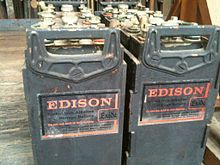Nickel-iron battery

Nickel–iron batteries manufactured between 1972 and 1975 under the "Exide" brand originally developed in 1901 by Thomas Edison.
|
|
| Specific energy | 19-25 Wh/kg |
|---|---|
| Energy density | 30Wh/l |
| Specific power | 100 W/kg |
| Charge/discharge efficiency | <65% |
| Energy/consumer-price | 1.5 – 6.6 Wh/US$ |
| Self-discharge rate | 20% – 30%/month |
| Time durability | 30 – 50 years |
| Cycle durability | Repeated deep discharge does not reduce life significantly. |
| Nominal cell voltage | 1.2 V |
| Charge temperature interval | min. −40 °C – max.46 °C |
The nickel–iron battery (NiFe battery) is a rechargeable battery having nickel(III) oxide-hydroxide positive plates and iron negative plates, with an electrolyte of potassium hydroxide. The active materials are held in nickel-plated steel tubes or perforated pockets. It is a very robust battery which is tolerant of abuse, (overcharge, overdischarge, and short-circuiting) and can have very long life even if so treated. It is often used in backup situations where it can be continuously charged and can last for more than 20 years. Due to its low specific energy, poor charge retention, and high cost of manufacture, other types of rechargeable batteries have displaced the nickel–iron battery in most applications.
Nickel–iron batteries have long been used in European mining operations because of their ability to withstand vibration, high temperatures and other physical stress. They are being examined again for use in wind and solar power systems where battery weight is not important.
Many railway vehicles use Ni–Fe batteries. Some examples are London underground electric locomotives and New York City Subway car – R62A.
The technology has regained popularity for off-the-grid applications where daily charging makes it an appropriate technology.
Nickel–iron batteries are being investigated for use as combined batteries and electrolysis for hydrogen production for fuel cell cars and storage. Those "battolysers" could be charged and discharged like conventional batteries, and would produce hydrogen when fully charged.
The ability of these batteries to survive frequent cycling is due to the low solubility of the reactants in the electrolyte. The formation of metallic iron during charge is slow because of the low solubility of the ferrous hydroxide. While the slow formation of iron crystals preserves the electrodes, it also limits the high rate performance: these cells charge slowly, and are only able to discharge slowly. Nickel–iron cells should not be charged from a constant voltage supply since they can be damaged by thermal runaway; the cell internal voltage drops as gassing begins, raising temperature, which increases current drawn and so further increases gassing and temperature.
...
Wikipedia
